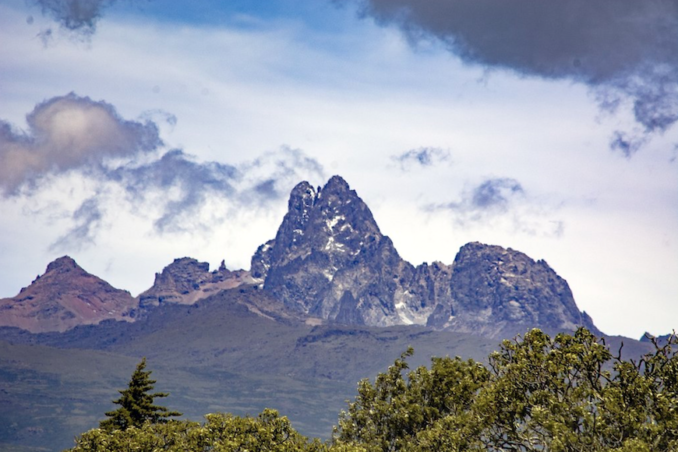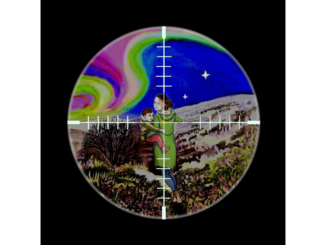In 1955, at the height of the Mau Mau Rebellion, my uncle John Alldridge produced a series of reports from Kenya for the Birmingham Mail and the Manchester Evening News – Jerry F
Tactical Force Headquarters, East Africa Command, Nyeri, Kenya
The tiny plane hangs like a hawk on the blue African sky. A thousand feet below us is the cap of forest, a frozen sea of olive green. Nothing moves down there. No breath of air stirs the tight-packed foliage. It seems a dead world from which frightened man has long since fled.
We cruise around watching idly as the little aircraft throws a giant shadow cross over the dense green roof. We do not speak: for we are infected by the uncanny silence of the world below.
Suddenly, the radio, which has been quiet for so long, stutters into nervous life. Through a muddle of static we hear a voice coming up to us, a young voice which I would place not five miles from Birmingham. The young pilot of the Kenya Police Reserves Air Wing grins and points down somewhere into that wild wood. “That will be Banker Company of the Koylis. They’ll be bellyaching again about the biscuit. Listen.”
I listen. A thousand feet below us a British sergeant in a tent, cunningly hidden by brush and plaited branches, is talking to a man he has never seen, but who is as familiar and as necessary to his existence as the grocer’s boy back home in Handsworth. Around him, stripped to the waist, will be three young National Servicemen, their white English skins tanned now to the colour of good coffee. They will be lounging at rest, but you will see how they cuddle their rifles. In the forest there is time for only one shot.
A thousand yards away, perhaps — though it might be a thousand miles in this tangled wood — the rest of the patrol is following in Indian file along an elephant track (the elephant were here last night: you can see the fresh droppings). Ahead of them goes their Kikuyu tracker, his impassive black face lost in the shadow. With them, too, goes Rex, their Alsatian tracker dog, and his handler, a Royal Army Veterinary Corps man from Grantham.
Only the sergeant is more than 20, and here they are now in a game preserve a thousand feet up on the slopes of Mount Kenya, the second highest mountain in Africa. The game they are hunting is the shyest game of all — desperate man…
The pilot has finished making up his “shopping list.” One more request for bread instead of the eternal biscuit has been duly noted (even though in this heat fresh bread is as brittle as toast after two hours in the sun). The platoon’s situation report has been passed on to be sorted out, with a mass of others, by Brigade Intelligence far down below. A sack of cigarettes, newspapers, mail goes twisting and turning down, down, down to those invisible men in that eternal forest.
We shall waggle our wings in “goodbye” and head for home, which is a few tents around a dusty airstrip at Nanyuki. Down in the forest Operation First Flute goes on…
Reading the bare facts in your paper over breakfast tomorrow morning Operation First Flute must seem a simple, straightforward affair. Somewhere up in the forest and moorland of Mount Kenya — their traditional hunting ground — are a handful of desperate Mau Mau terrorists. The official estimate of their number is cautious, but 3,000 might come near enough. They have been lying up there hiding under the great roots of ancient trees, in caves under waterfalls, since Operation Hammer blasted and flushed them out of their hereditary sanctuary in the wooded Aberdare Mountains, 20 miles to the west.
Nominally, this ragged half-starved army of guerrillas, armed with a few stolen shotguns, automatics and some pathetic home-made “rifles,” is commanded by a renegade corporal of the King’s African Rifles, one “General” Dedan Kimathi. But in fact this so-called Kenya liberation army has deteriorated into a score of independent self-contained gangs, linked vaguely in stubborn resistance against a common enemy.
Opposed to them are three battalions of veteran British Infantry — the King’s Own Yorkshire Light Infantry, the Royal Northumberland Fusiliers and the Rifle Brigade — three battalions of the King’s African Rifles raised here in Kenya and famous fighters on their own ground, and 2,500 Meru Home Guard armed with shotguns, rifles and spears. For close support they have a regiment of ack-ack guns and regular round-the-clock air strikes, delivered by a mixed squadron of R.A.F. Lincolns and Vampire jets. The job of the infantry is to flush the Mau Mau out of their holes. Afterwards the R.A.F. go in to bomb and strafe (and they go in close, those clumsy old Lincolns). Going down to 200 feet to machine-gun a forest ride is no picnic, as I found out yesterday. That was the one morning when I wanted no breakfast.
Yet the results, so far, of Operation First Flute — now in its third week — have been disappointing, to say the least. The bag to date counts: 45 Mau Mau killed and nine captured — not much to show for a military and civilian operation which, in all its phases, is costing around a million pounds a month.
How is it that a handful of starving scarecrows can defy an experienced well-equipped military force of 8,000 professionals? There are two reasons, as I see it. The first is the nature of the country itself. This must be the most formidable battlefield in the world — not excepting even Malaya.
From the verandas of fashionable resort hotels like The Mawingo, at Nanyuki, the snowcapped peaks of Mount Kenya, towering 17,040ft. high, are fabulously beautiful, particularly in the dawn light. In close-up it becomes a nightmare, even for experienced mountaineers. Once you are in the forest itself — and the forest begins around the 5,000ft. contour — you have a second 5,000ft. of tight-packed cedar and camphor and yellowood and bamboo to hack your way through. From then, on to the top, you are above the snow-line among dead craters and glaciers interspersed with tussocks of grass and heather as high as a tall man. This is something left over from the ice age. “It’s like being on the mountains of the moon,” the Colonel of the Fusiliers put it to me. And that is a fair description.

Galkey.
The ruggedness and vastness of Mount Kenya,
Galkey – Licence CC BY-SA 4.0
Nothing daunted, these young British infantrymen are carrying out a series of slow, meticulous sweeps which started up there among the snow — higher than British troops have ever operated before — and are now down among the bamboo and the scrub. Here the real danger is not from hidden Mau Mau, but from herds of stampeding elephant and rhino maddened by the bombing. Only last week the C.O. of the Koylis was charged by an enraged rhino. Patrols trekked for hours by buffalo are an everyday occurrence. A patrol of Yorkshiremen, camped out on the line near the edge of the forest, told me their only “nuisance” were scavenging wildcats that prowled around their bivouac at night.
The second element in favour of the Mau Mau gangster is his intimate knowledge of this kind of country. For sheer fieldcraft he would make the old-time Redskin look like a tenderfoot. He can go to earth for days in a ditch, or under a bush, while patrols looking for him walk right over his face — as actually happened on one patrol last week.
This is a phantom army of invisible men that only operates by night — and then only to forage for food and ammunition. For a fortnight a whole battalion of the King’s African Rifles — experienced woodsmen all of them — have been combing by day and laying ambush by night an area of only 3,000 square yards. In that time they have seen four Mau Mau and killed two (they also shot a lion — but only in self-defence. For, ironically, though man may be shot on sight, animals are strictly protected up here.)
But if the Mau Mau remain invisible they see and note every move made against them. Moving up to a forward position in a forest clearing yesterday I had the uncomfortable feeling that savage eyes were watching me all the way.
So, apart from healthy outdoor exercise throughout enjoyed by all ranks in wonderful weather, and the fact that there have been no casualties from enemy action to date, the Army, to use its own expression, “is having no joy.” And somewhere up there in the mountain General Dedan Kimathi is counting on that simple but deadly weapon — frustration — as his last hope.
In a few weeks the big rains are due and then life up here will be impossible to all but a desperate African. And no doubt he knows that if he can continue to be supplied with food and ammunition from “loyal” frightened Kikuyu on the reserve — as he most certainly is now — then he can hope to prolong his stalemate war indefinitely.
His opposite number, Major-General W.R.N. Hinde, C.B.E., D.S.O., the British Field Commander, summed it up to me as “a long, bitter, frustrating, expensive business.” And whatever the final outcome on Mount Kenya, it seems as if a considerable military force will have to be maintained in Kenya for a long time to come, and at a million pounds a month — or even half a million pounds — that is quite an item. How the British taxpayer has become responsible for that item on his debit-account I hope to show in succeeding articles.
Reproduced with permission
© 2024 Newspapers.com
For more information, see:
Robert Hinde (British Army Officer)
Dedan Kimathi
Jerry F 2024



